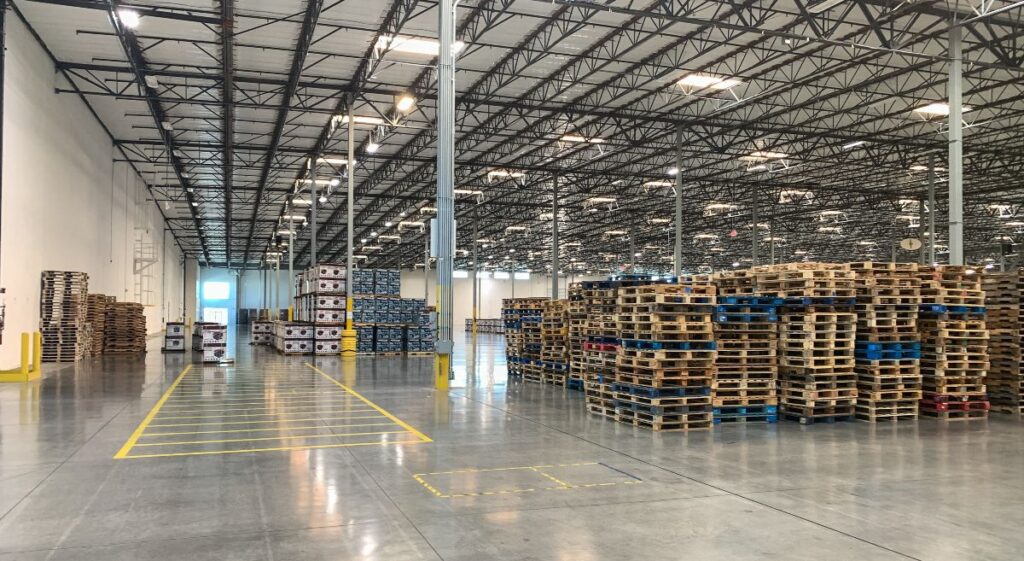When it comes to protecting the longevity of your industrial floors, regular floor waxing isn’t something that should go overlooked. Floor waxing offers numerous benefits for commercial floors, which can help you save time and money in the long run – which is important for every business.
Regular floor waxing for industrial floors not only improves their aesthetic appearance, but it also helps to protect them from spills, dirt, and wear and tear. Considering all of the advantages, it is not a surprise that the floor waxing market is flourishing.
From reduced cleaning time to enhancing safety regulations, let’s dive into some great reasons why you should make regular floor waxing part of your facility’s maintenance routine. So, let’s take a look at the biggest advantages of floor waxing for industrial floors:
What is floor waxing?
Floor waxing is a specialized technique used for protecting hardwood, vinyl, terra cotta, or stone floors. It guards them against scratches and dirt, improves shine, and greatly extends the floor’s life expectancy.
The procedure involves removing any existing coatings, cleaning, and applying wax with either a roller applicator or mop in multiple layers, depending on the size and material of the floor. Once finished, polishing with high-speed buffers increases the final sheen.
1. Maintaining a safe environment
Regular floor waxing for industrial floors offers many advantages, but improved floor safety is undoubtedly among the most important ones. A safe working environment is essential for employee health and well-being, as well as increasing workplace productivity.
Slip resistance plays an important role in providing a secure work environment, which encourages employees to focus on their tasks instead of worrying about potential hazards. The Consumer Product Safety Commission (CPSC) reports that surfaces and flooring materials are a contributing factor in over two million slips, trips, and falls each year. Regular waxing of floors can reduce slipping incidents, creating a safer environment for employees.
Waxing can enhance traction and reduce slipperiness, minimizing the risk of accidents and injuries in a busy workplace environment. This is especially important when dealing with wet or slippery surfaces that could pose a challenge to those walking on them.
Floor waxing aids compliance with standards set by bodies such as OSHA. It increases a surface’s coefficient of friction, reducing the likelihood of slips and falls.
Furthermore, regular cleaning and maintenance will prevent dirt accumulation, avoiding hazardous slipping caused by oil, grease, or water spills. With these practices in place, industrial floor safety is improved, and injury-causing slips and falls are avoided.
2. Enhanced professionalism and aesthetics
The next benefit of regular floor waxing for industrial floors is enhanced professionalism and aesthetics.
By waxing industrial floors regularly, businesses can create a professional environment that leaves a positive impression on customers, visitors, and employees alike.
The reflective surface of waxed floors enhances the overall brightness and attractiveness of the space, creating an inviting atmosphere that encourages customer engagement.
This improved appearance contributes to the professionalism of any business establishment. Waxing can create a glossy finish, transforming even the oldest and most outmoded industrial spaces into modern, welcoming environments for customers.
A clean and well-presented workplace also boosts employee morale and motivation while creating a positive atmosphere for productivity.
This makes for more efficient working conditions, ultimately leading to better performance among workers. With freshly applied wax on the floors, employees can feel proud of their work environment, which often translates into greater enthusiasm for their tasks throughout the day.
However, it’s important to keep in mind that not all companies that offer industrial floor waxing are the same. If you are looking for an experienced and professional company with attention to detail, look no further than TCS Floors.

3. Protection against wear and tear
Floor waxing for industrial floors creates a thin protective layer, covering it against scratches, stains, and abrasions. This protective layer helps preserve the underlying surface materials as well as maintain their appearance over time.
Regular waxing also reduces the need for future repairs or replacements by significantly extending the lifespan of the industrial floor. Let’s sum it up:
- Wax forms a protective barrier on top of the floor surface which prevents dirt, dust, moisture, etc., from damaging it further.
- The top coat provides a layer that deflects dirt and other debris away from the underlying material so that it looks better for longer periods.
- When properly applied, this coating creates an additional cushion between any shoes or equipment used on it thus reducing chances of enduring scuffs or marks while walking on it.
- By preserving its structure with regular wax applications, you can extend its life considerably compared to leaving it unprotected.
- Foot traffic and moving heavy objects can cause scratches in your flooring, resulting in a dull or worn-out appearance.
- Regular waxing services can restore the sheen of your floors and guard against further damage. Wax forms an invisible protective film to resist scratching from frequent foot traffic, and dragging large items across it.
When done correctly, regular floor waxing can be highly beneficial for any industrial workspace looking to keep its floors in good condition for as long as possible.
4. Easier maintenance and cleaning
When it comes to easier maintenance and cleaning, regularly waxed industrial floors are ideal for any commercial or industrial facility.
This will help reduce the frequency of deep cleanings, which require more time and effort. The smooth, sealed surface makes it easier for staff to quickly wipe away messes before they get out of hand.
Regular waxing not only makes it easier to clean but also stops discoloration from spills or chemical exposure. This is especially beneficial for high-traffic areas such as petrochemical plants, warehouses, and manufactories, keeping their original appearance year-round.
Floor waxing prevents dirt from building up on surfaces, reducing the amount of time needed to mop up messes in break areas and production lines at the end of each shift.
5. Cost reduction and long-term savings
Wax creates a protective shield that prevents wear and tear from dirt, dust, moisture, spills, and other contaminants, as mentioned above. For the long-term preservation of the floor surface, this lessens abrasion caused by furniture movement and foot traffic.
For this reason, one of the biggest benefits of floor waxing for industrial floors is cost reduction.
Modern sealing products are cost-effective for businesses, providing reliable protection with fewer re-applications of wax sealant. This minimizes purchase costs and labor expenses associated with machinery and brushes, which are needed for proper wax application.
Investing in regular floor waxing for industrial ground care is a wise decision that pays off over the long term.
It increases the longevity of floors, protects against abrasive wear and tear, and improves aesthetic appeal without significantly increasing upfront costs or negatively impacting service quality.
Regular cleaning and maintenance of hard surfaces within an establishment or workplace facility can save money in the long term while protecting against dirt build-up.
This increases durability, thereby extending the life of the surface and providing a lasting shine that helps create good impressions on visitors.
6. Environmental benefits
Regular floor waxing for industrial floors is an important part of maintaining industrial floors while minimizing environmental impact.
Waxing helps protect the underlying floor surface and improves indoor air quality while also reducing chemical usage and water consumption during maintenance activities.
- Reduced chemical usage: Waxed floors are easier to clean and maintain, resulting in a reduction in the use of harsh chemicals that can harm the environment when produced, used, or disposed of.
- Enhanced durability and lifespan: Regular waxing helps extend a floor’s life by protecting it from wear and tear, leading to less resource consumption in the long run.
- Improved indoor air quality: Waxed floors create a smoother surface that traps fewer dust particles, allergens, or pollutants – improving the overall air quality inside buildings.
- Reduced water usage: Waxed floors resist stains better, ensuring minimal water consumption during cleaning activities and supporting water conservation efforts throughout the industry.
- Lower energy consumption: Floor waxing can help increase the amount of light reflection in industrial facilities, reducing the need for additional lighting and consequently lowering energy consumption. This not only helps reduce costs but also contributes to a smaller carbon footprint.
Waxing hard surface floors regularly offers many environmental benefits, such as cutting back on energy and chemical usage for cleaning and reducing waste associated with manufacturing new materials.
Industrial facilities and commercial businesses especially can benefit from this practice to help preserve resources while enhancing their workspace.
7. Diminished appearance of grooved and faults
Industrial floors are prone to wear and tear that can lead to degradation in appearance over time. Grooves, irregularities, dirt, debris, and chemicals worsen this look further. To ensure the longevity of your flooring’s condition and aesthetics, it is important to engage in preventative maintenance such as regular waxing for industrial floors.
Regular waxing can help minimize the visibility of grooves and irregularities on your industrial floors. Over time, dirt, debris, and chemicals can cause these imperfections to develop.
You can fill in these crevices, resulting in a smoother and more polished look for your floors by applying wax regularly. This not only enhances their appearance but also helps prevent costly repairs.
Moreover, addressing and filling in grooves is not just about aesthetics. Regular maintenance is key to keeping floor surfaces in optimal condition. Cleaning machines, detergents, and industrial-grade waxes are essential for achieving a long-term reduction in material expenses.
Regular Industrial Floor Waxing: A Wise Investment
Regular industrial floor waxing offers a range of significant benefits, including improved safety, aesthetics, and cost-effectiveness. It protects floors from wear and tear, simplifies cleaning and maintenance tasks, reduces associated costs over time, improves the appearance of grooves and faults, and has environmental advantages.
Investing in regular floor waxing for industrial floors will make your facility safer for employees and give it a professional look that impresses visitors. Make sure to prioritize this form of care to promote productivity and increase the value of your investment by hiring professional services with TCS Floors.
FAQ
How long does floor waxing last?
The duration of floor waxing largely depends on factors such as foot traffic, maintenance practices, and the quality of the wax used. Generally, a properly applied wax coating can last anywhere from several months to a year.
High-traffic areas may require more frequent waxing, while low-traffic areas may maintain their waxed appearance for a longer period. Regular cleaning and maintenance, including routine buffing and reapplication of wax, can help extend the lifespan of the wax coating.
More on how long floor waxing lasts here.
How long does it take to strip and wax 1000 square feet?
The time required to strip and wax 1000 square feet of flooring depends on factors such as the condition of the floor, the number of layers to be removed, and the complexity of the job.
On average, it can take approximately 4-8 hours for a professional floor cleaning service to complete the process.
More on stripping and waxing 1000 square feet here.
How often do floors need to be stripped and waxed?
The frequency of stripping and waxing floors depends on factors such as foot traffic, maintenance practices, and the type of flooring.
Generally, high-traffic areas may require stripping and waxing every 6-12 months, while low-traffic areas may only need it every 1-2 years. Regular cleaning and maintenance can help extend the time between stripping and waxing.

